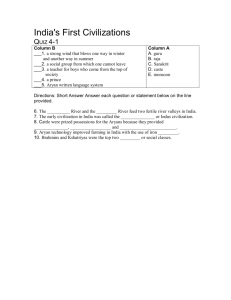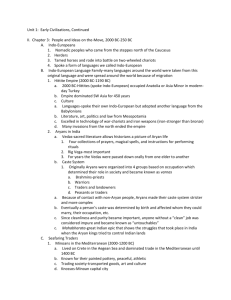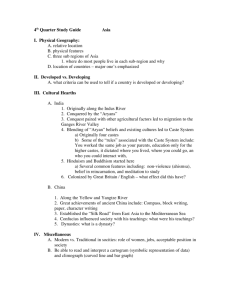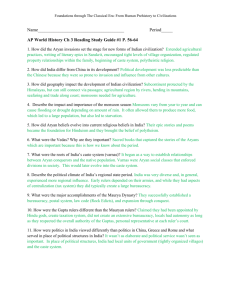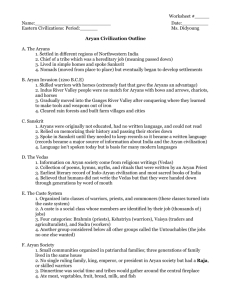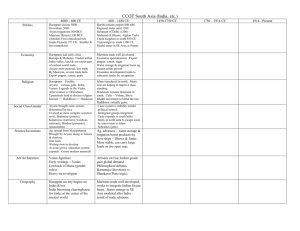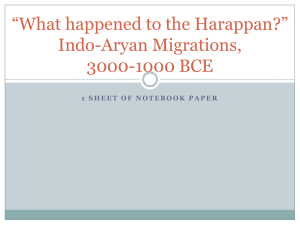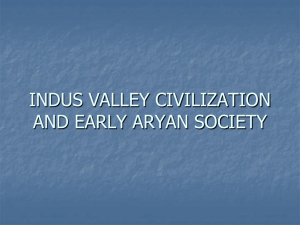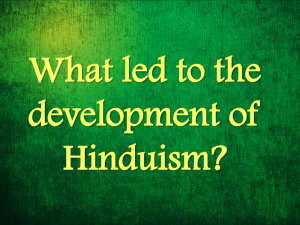Where did the Aryans come from and why?
advertisement
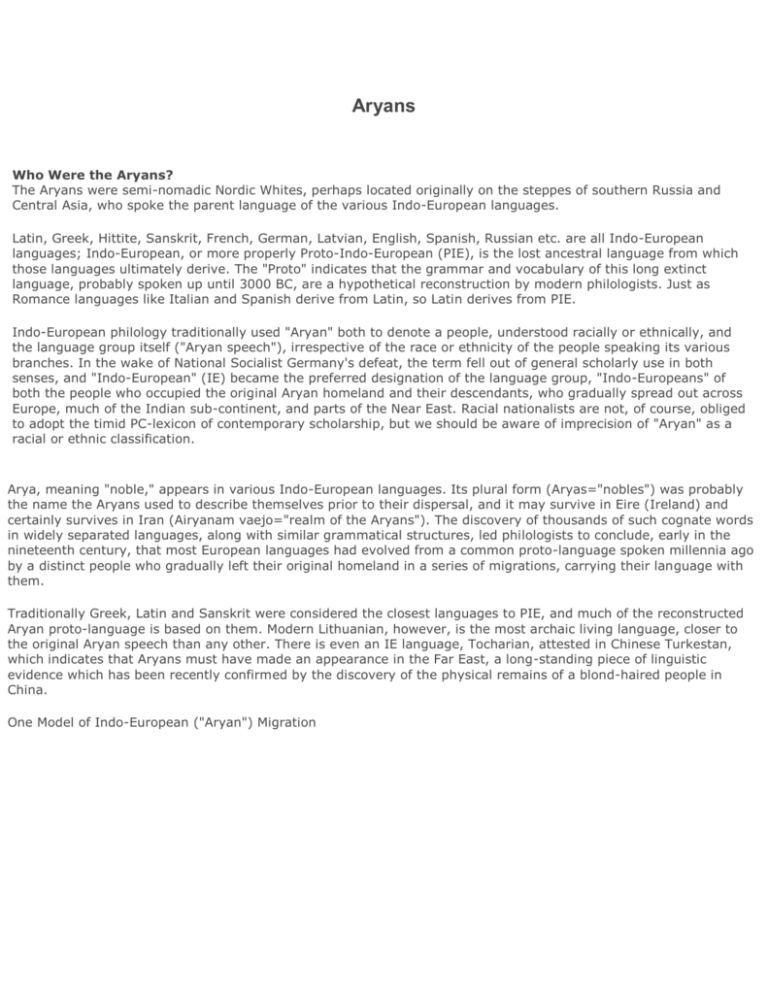
Aryans Who Were the Aryans? The Aryans were semi-nomadic Nordic Whites, perhaps located originally on the steppes of southern Russia and Central Asia, who spoke the parent language of the various Indo-European languages. Latin, Greek, Hittite, Sanskrit, French, German, Latvian, English, Spanish, Russian etc. are all Indo-European languages; Indo-European, or more properly Proto-Indo-European (PIE), is the lost ancestral language from which those languages ultimately derive. The "Proto" indicates that the grammar and vocabulary of this long extinct language, probably spoken up until 3000 BC, are a hypothetical reconstruction by modern philologists. Just as Romance languages like Italian and Spanish derive from Latin, so Latin derives from PIE. Indo-European philology traditionally used "Aryan" both to denote a people, understood racially or ethnically, and the language group itself ("Aryan speech"), irrespective of the race or ethnicity of the people speaking its various branches. In the wake of National Socialist Germany's defeat, the term fell out of general scholarly use in both senses, and "Indo-European" (IE) became the preferred designation of the language group, "Indo-Europeans" of both the people who occupied the original Aryan homeland and their descendants, who gradually spread out across Europe, much of the Indian sub-continent, and parts of the Near East. Racial nationalists are not, of course, obliged to adopt the timid PC-lexicon of contemporary scholarship, but we should be aware of imprecision of "Aryan" as a racial or ethnic classification. Arya, meaning "noble," appears in various Indo-European languages. Its plural form (Aryas="nobles") was probably the name the Aryans used to describe themselves prior to their dispersal, and it may survive in Eire (Ireland) and certainly survives in Iran (Airyanam vaejo="realm of the Aryans"). The discovery of thousands of such cognate words in widely separated languages, along with similar grammatical structures, led philologists to conclude, early in the nineteenth century, that most European languages had evolved from a common proto-language spoken millennia ago by a distinct people who gradually left their original homeland in a series of migrations, carrying their language with them. Traditionally Greek, Latin and Sanskrit were considered the closest languages to PIE, and much of the reconstructed Aryan proto-language is based on them. Modern Lithuanian, however, is the most archaic living language, closer to the original Aryan speech than any other. There is even an IE language, Tocharian, attested in Chinese Turkestan, which indicates that Aryans must have made an appearance in the Far East, a long-standing piece of linguistic evidence which has been recently confirmed by the discovery of the physical remains of a blond-haired people in China. One Model of Indo-European ("Aryan") Migration Perhaps the most famous proof for the prehistoric existence of PIE is the word for king: rex in Latin, raja in Sanskrit, ri in Old Irish, along with a host of other cognates. All are obviously variants of a common word for king. Since none of the peoples speaking these various languages were in physical contact with one another during the historical period -- i.e. at a time for which written records exist -- comparative philologists inferred that their respective languages must have evolved from a single proto-language, which is the only way of explaining the presence of the same word for "king" among such widely dispersed peoples. The Romans clearly didn't borrow rex from the Irish or the IndoAryans; each had instead inherited their own word for "king" from a common ancestral language. Philologists can also, moreover, safely conclude that the Aryans must have had kings prior to emigrating from their original homeland in southern Russia. In fact a fairly detailed body of evidence about prehistoric Aryan political organization, marriage practices, and religious beliefs can be reconstructed on the basis of the survival of common vocabulary in the various extant Indo-European languages: They worshiped a sky-god, they traced descent through the male line, they raised cattle, they drank meed, they used horse-drawn chariots (which they probably invented) as weapons of war, etc. Even the red, white and blue/green that appears in so many modern flags may have an Aryan pedigree. It is likely a survival from the Aryan tripartite social division of their communities into priests (white), warriors (red), and herders and cultivators (blue/green). Aryans, or more specifically Indo-Aryans, make their first notable appearance in history around 2000-1500 BC as invaders of Northern India. The Sanskrit Rig Veda, a collection of religious texts still revered by modern Hindus, records (often enigmatically) their gradual subjugation of the dark-skinned inhabitants, the Dasyus: e.g. "Indra [=Norse Thor, Celtic Taranis] has torn open the fortresses of the Dasyus, which in their wombs hid the black people. He created land and water for Manu [=Aryan man]"; "lower than all besides, hast thou, O Indra, cast down the Dasyus, abject tribes of Dasas"; "after slaying the Dasyus, let Indra with his white friends win land, let him win the sun and water"; "Indra subdued the Dasyu color and drove it into hiding." With all-outstripping chariot-wheel, O Indra, Thou, far-famed, hast overthrown the twice ten kings ... Thou goest from fight to fight, intrepidly Destroying castle after castle here with strength. (RV 1.53) The Aryans were remarkably expansionist, and almost everywhere they went they conquered and subjugated the indigenous peoples, imposing their languages and (to varying degrees) their religious beliefs on the natives, and receiving in turn contributions from the peoples whom they conquered. Aryan invasions -- or more accurately, a long sequence of different invasions by speakers of Indo-European languages -- swept across Old Europe beginning as early as the fourth millennium BC, and over time the conquerors and the conquered melded into specific peoples with distinctive languages. Most of the contemporary inhabitants of Europe, along with their respective early national cultures, are the result of interaction between successive waves of Aryan invaders and culture of the particular White people that they conquered and with whom they later intermarried, and as a result almost all modern European languages are members of the Western branch of the IE family tree. The birth of a European culture, however, predates the arrival of the Indo-Europeans: The cave art of Lascaux, which some have identified as the first flowering of Western man's creative genius, was the work of Old Europeans, as were Stonehenge in the North and the Minoan Palace culture of Crete in the South. A pan-European religious symbolism had already evolved, much of which was later incorporated into IE mythologies, including various regional adaptations of the ubiquitous Old European reverence for the Mother Goddess. Many of the principal figures in Greek mythology predate the arrival of Aryans, and during the course of ancient history Old European religious beliefs and practices continually reasserted themselves. [Image: Minoan snake goddess, from the Palace of Minos, circa 1600 BC] Europe is European because the conquerors and the conquered were members the same White race, different branches on the same family tree; India is a morass of poverty because the bulk of the conquered, with whom the Indo-Aryans eventually intermarried, were non-White Veddoids. The lesson is obvious. Even today high-caste Hindus can still be identified by their Caucasian features and light skin, and the poorest and most backward parts of India are generally the darkest. As an aside, recent genetic studies have indicated that the Basques of Aquitaine and the Pyrenees are probably the purest form of Old Europeans as they existed prior to the arrival of Indo-European invaders. They evidently emerged from the invasions of Europe unconquered, and they remained sufficiently isolated to retain their own unique, non-IE language http://paganizingfaithofyeshua.netfirms.com/aryan_people_and_origin_of_cx_doctrine.htm Social Classes and Castes in Ancient India Please note: Most of this information has been abridged and adapted from the Mystica site @ Indiaculture online. Likewise, most of the images are taken from their site. [Subject to permission.] - See their entire website by pressing [here]. The Rig-Veda (a holy book), divides ancient Indian society into four separate but interdependent castes or classes of people. According to the Puranas (another holy book of Hindu religion), the Brahmins or priests were born of the mouth of Lord Brahma and can speak with and pray to the gods on behalf of mankind. The Kshatriyas or rulers and warriors were born of Lord Brahma's arms and were given the task of protecting society and using weapons. The Vaishyas (business people and originally farmers) were born of his thighs and took care of trade, business activities, and farming. The Shudras (or common laborers) were born of Brahma's feet and their only purpose was to serve the other three castes. They became almost like slaves. This group became the farmers and herders as the business class became richer and more powerful. In addition to the four named castes, another category was later made. This category of people called the Chandalas. They were the outcastes or "untouchables" that were considered outside of the system. They did not live within the cities or villages, nor were they allowed to enter, except to scavenge and collect night soil (manure). This "caste sytem" grew in the later days of Magadhan imperialism (i.e. after 500 B.C.E.). Buddhism and Jainism were both against this system and drew converts from all groups of people. Caste based on race? The three upper castes became known as 'svarna jati' or castes of 'good color' or 'golden color'. According to one theory (of "Aryan Invaders") the lighter skinned Aryans created a system of privilege for themselves. Caste itself devolved into a racial differentiation between the conquerors and the conquered, with color as the most visible distinction. From another point of view, the Aryans entered India that already had a class system. Darker skinned people were found in Southern India (with their skin color as a protection against the sun). Reincarnation - Can one be reborn into a higher caste? The Hindus believe that the caste that one is born into is based on the karma and dharma of one's previous birth. A good karma and dharma will ensure that one is born into a higher caste in one's next life. Otherwise, one could be punished by being born into a lower caste, or even as an animal! Brahmin Class Brahmins were "created from the mouth of Brahma" (the chief god), so that they might instruct mankind. Since knowledge is the only thing that remains with a person throughout life, Brahmins, as teachers, were highly respected. The Brahmins conducted the daily rites, the purification ceremonies, sacrifices, and taught the Vedas. After childhood, their lives were divided into four stages. During the "student period" of adolescence they studied under a guru (or teacher). About age 20 they entered the "householder stage" by taking a wife and raising family. This was up to the age of 50. Then they began old age as "forest dwellers" up to the age of 70. They lived simply away from society in the forest, performed sacrifices, and prepared to renounce all worldly associations. Finally they renounced wealth and worldly pleasures. They were completely detached from the rest of the world giving up even family ties. Instead, they sought alms ("begged") from householders and spent their time meditating trying to achieve salvation. Since they were the teachers, preachers and priests they had to be skilled in sacred knowledge of the Vedas, or holy texts. They had to maintain a strict code of conduct and exemplify ideal behavior. They were to be kind and gentle. For this, they earned certain privileges and were treated almost like gods by commoners and kings alike. Only a priest could partake of the sacrifices and eat the remains of the sacrifices, for no one else was thought to be holy enough to eat the divine leftovers. At first, a person became a Brahmin because he knew the Vedas. In time, the Brahmins began interpreting laws to their own advantage to maintain their privileges. Because of their moral authority, they were unchecked. So only the Brahmins were allowed to read and teach the Vedas. They monopolized the privilege of priesthood in the later Vedic period. They also established that one was born into a caste, which could not be changed except to be outcaste, the lowest of the castes. This practice still survives until today. Brahmins spoke Sanskrit, the language of the holy books. Women of the Brahmin class could marry the Brahmin men, and after raising the family, they might join the Brahmin men who went into the forest to withdraw from society. Marriage was compulsory for all the girls except for those opted for asceticism. Brahman girls were married between ages 8 and 10 from the sixth century onwards up to modern times. To learn more about the Brahmin class, click [here]. Rulers and Warriors Class - "Kshatriya" or "protectors of gentle people" The Kshatriyas were kings and warriors. They were said to have come from the arms of Brahma, meaning that their role in society was the protection of people and livestock. They were supposed to be brave and fearless, and to live and die by a code of honor and loyalty. They could eat meat and drink liquor. Their most exalted death was to die in battle. Young men of this caste also studied with a guru (teacher) to learn the holy texts and become "twice born", but their training included the use of weapons. Only men of this class could have such training. Certain weapons were also forbidden to the other classes. Men of this class also spoke Sanskrit, while the lower classes spoke the common language of the area. Lord Rama with a bow Women of this caste had little political power. [Images courtesy of India Culture Online] Their families would often arrange their marriages to build alliances or to achieve other political or economic goals for the family. Polygamy (having more than one wife) was permitted to all who could afford and it was especially popular among Kshatriaysa for political reasons. Girls were married between ages 8 and 10. This class included the landowners. Vaishya - Traders and Merchants Third in the caste system, the Vaishya's duty was to ensure the community's prosperity through agriculture, cattle raising and trade. Later, the Shudras (or lower working class) took over agriculture and cattle rearing while the Vaishyas became traders and merchants. The Vaishya were said to have come from Braham's thighs. Young men of this caste also studied with a guru (teacher) to learn the holy texts and become "twice born". From the end of the 4th century BC, as the country became politically stable, trade routes to previously uncharted areas developed. The merchant community was the first to benefit. Artisans formed guilds (like a "trade union") and co-operatives in the urban areas. Guild leaders became important figures in society. Guilds also provided technical education, though formal education remained the monopoly of the Brahmins. As their economic power increased, they were expected to give alms (food and money) to Brahmins, throw feasts for them, and donate generously towards the building of temples and shrines. Even though they were educated about the holy texts and economically strong because they controlled commerce, Vaishyas were denied a high social status, for which they resented the upper castes. One expression of this resentment was their support of the anti-Brahminical sects that developed around the 6th century BC, like Buddhism and Jainism. Learn more about the Vaishyas by pressing [here]. The Shudras (or laborers) The Shudras took over the jobs of farming, herding, and manual labor for the higher classes. At times they were treated like slaves. Young men of this caste could not study with a guru (teacher) to learn the holy texts nor could they become "twice born". They could not get a formal education at all. Most of their lives were spent in hard labor. Both men and women were part of this caste. To learn more about the Shudras, press [here]. The Chandalas or "untouchables" The Chandalas were considered outside of the system of the other castes. They did not live within the cities or villages, nor were they allowed to enter during the day. At night they could enter to scavenge and collect night soil (manure). They had to move off the path if someone from a higher class approached because contact with such people was "contaminating". Hindu texts were interpretted as describing a class of people as foul and loathsome, and any physical contact with them was regarded as polluting. Indeed, the Untouchables' very shadows were considered polluting, and they were required to beat drums and make loud noises to announce their approach. Untouchables had to attach brooms to their backs to erase any evidence of their presence. Cups were tied around their necks to capture any spittle that might escape their lips and contaminate roads and streets. Their meals were taken from broken dishes. Their clothing was taking from corpses. They were forbidden to learn to read and write, and were prohibited from listening to any of the traditional Hindu texts. Untouchables were denied access to public wells. They cound not use ornaments and were not allowed to enter Hindu temples. They performed the jobs that no one else wanted to perform. The primary work of Untouchables included scavenging and street sweeping, emptying toilets, the public execution of criminals, the disposal of dead animals and human corpses, and the clean-up of cremation grounds. Surprisingly, musicians belonged to this class, too, but music was listened to by members of other castes. The daily life of the Untouchable was filled with degradation, deprivation and humiliation. [Some information for this section is from Caste and Race in India] Where did the Aryans come from and why? [Edit] In: Ancient Religions [Recategorize] [Edit] Answer The word Aryan is an archaic term for either the proto-Indo-European people who are believed to have originated in central Russia, or the proto-Indo-Iranian people who originated in southern Russia. As part of the mass migration of people over many thousands of years, proto-Indo-European people migrated westward into much of Europe, taking their language with them. Not all these people migrated westward, and a proto-Indo-Iranian culture developed in the south of Russia, probably around 2500 BCE. A few centuries later, a group migrated south-east into India, taking both language and the early Hindu religion with them. A later group also migrated south, to the east of the Caspian Sea, into eastern Iran, also taking language and the Zoroastrian religion. A third group migrated south, around the western edge of the Caspian Sea into western Iran. This last group, which was to become the Medes and Persians, took an older religion with them but converted, centuries later, to Zoroastrianism.
